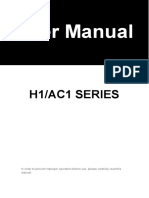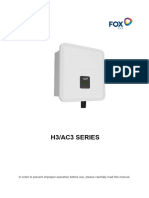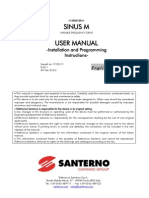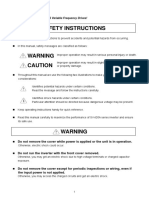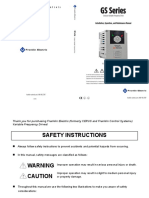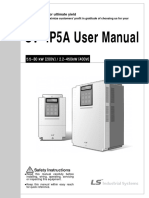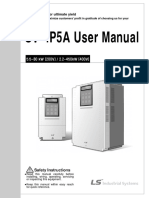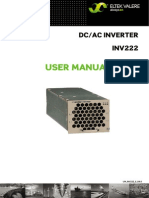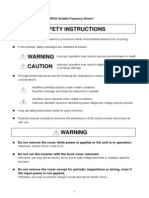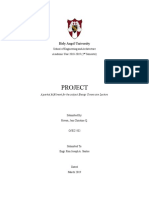E F User Manual
Uploaded by
Jose Mari Llado JimenezE F User Manual
Uploaded by
Jose Mari Llado JimenezTable of Contents
1. Important Notes ........................................................................................................................................................ 2
1.1 Scope................................................................................................................................................................... 2
1.2 Target Group .................................................................................................................................................... 2
1.3 Symbols Used ................................................................................................................................................... 2
1.4 Symbols Explanation ...................................................................................................................................... 2
2. Safety ............................................................................................................................................................................ 3
2.1 Appropriate Usage ......................................................................................................................................... 3
2.2 PE Connection and Leakage Current ....................................................................................................... 4
2.3 Surge protection devices (SPDs) for PV installation ............................................................................ 4
3. About Product ........................................................................................................................................................... 5
3.1 About E Series and F Series Inverter......................................................................................................... 5
3.2 Basic Features ................................................................................................................................................... 5
3.3 Terminals Introduction .................................................................................................................................. 6
3.4 Dimensions ........................................................................................................................................................ 7
4. Technical Data ........................................................................................................................................................... 7
4.1 DC Input ............................................................................................................................................................. 7
4.2 AC Output ......................................................................................................................................................... 7
4.3 Efficiency, Safety and Protection................................................................................................................ 8
4.4 General Data ..................................................................................................................................................... 8
5. Installation ................................................................................................................................................................... 9
5.1 Packing List........................................................................................................................................................ 9
5.2 Preparation........................................................................................................................................................ 9
5.3 Installation Space Required ....................................................................................................................... 10
5.4 Tools Required ............................................................................................................................................... 10
5.5 Installation Steps ........................................................................................................................................... 10
5.6 Wiring Steps.................................................................................................................................................... 11
5.7 Earth Connection........................................................................................................................................... 14
5.8 Communication Device Installation (Optional) ................................................................................... 14
5.9 Inverter Start-Up ........................................................................................................................................... 19
5.10 Inverter Switch Off ........................................................................................................................................ 19
6. Operation .................................................................................................................................................................. 20
6.1 Control Panel .................................................................................................................................................. 20
6.2 Function Tree.................................................................................................................................................. 21
7. Maintenance ............................................................................................................................................................. 21
7.1 Alarm List ......................................................................................................................................................... 21
7.2 Troubleshooting ............................................................................................................................................ 23
7.3 Routine maintenance ................................................................................................................................... 23
8. Decommissioning ................................................................................................................................................... 24
8.1 Dismantling the Inverter ............................................................................................................................. 24
8.2 Packaging ........................................................................................................................................................ 24
8.3 Storage and Transportation ...................................................................................................................... 24
E/F Series User Manual www.fox-ess.com Page | 1
1. Important Notes
1.1 Scope
This manual describes the assembly, installation, commissioning, maintenance and troubleshooting of the
following model(s) of FoxESS products:
E Series:
E3000 E3600 E4600
E5000 E5300* E6000
F Series:
F4600 F5000 F5300*
F6000
Note: Please keep this manual where it will be accessible at all times.
*India only
1.2 Target Group
This manual is for qualified personnel only. The tasks described in this manual will need to be performed by
professional, suitably qualified technicians only.
1.3 Symbols Used
The following types of safety instructions and general information appear in this document as described below:
Danger!
“Danger” indicates a hazardous situation which, if not avoided, will result in death or serious
injury.
Warning!
“Warning” indicates a hazardous situation which, if not avoided, could result in death or
serious injury.
Caution!
“Caution” indicates a hazardous situation which, if not avoided, could result in minor or
moderate injury.
Note!
“Note” provides important tips and guidance.
1.4 Symbols Explanation
This section explains the symbols shown on the inverter and on the type label:
Symbols Explanation
Symbol Explanation CE mark. The inverter complies with the requirements of the applicable CE
guidelines.
E/F Series User Manual www.fox-ess.com Page | 2
Beware of hot surface. The inverter can become hot during operation. Avoid contact during
operation.
Danger of high voltages.
Danger to life due to high voltages in the inverter!
Danger.
Risk of electric shock!
Danger to life due to high voltage.
There is residual voltage in the inverter which needs 5 min to discharge.
Wait 5 min before you open the upper lid or the DC lid.
TUV certification
Read the manual
Product should not be disposed as household waste
2. Safety
2.1 Appropriate Usage
The E Series and F Series inverter is designed and tested in accordance with international safety requirements.
However, certain safety precautions must be taken when installing and operating this inverter. The installer must
read and follow all instructions, cautions and warnings in this installation manual.
▪ All operations including transport, installation, start-up and maintenance, must be carried out by qualified,
trained personnel.
▪ The electrical installation & maintenance of the inverter shall be conducted by a licensed electrician and shall
comply with local wiring rules and regulations.
▪ Before installation, check the unit to ensure it is free of any transport or handling damage, which could affect
insulation integrity or safety clearances. Choose the installation location carefully and adhere to specified
cooling requirements. Unauthorized removal of necessary protections, improper use, incorrect installation
and operation may lead to serious safety and shock hazards or equipment damage.
▪ Before connecting the inverter to the power distribution grid, contact the local power distribution grid
company to get appropriate approvals. This connection must be made only by qualified technical personnel.
▪ Do not install the equipment in adverse environmental conditions such as in close proximity to flammable
or explosive substances; in a corrosive environment; where there is exposure to extreme high or low
temperatures; or where humidity is high.
▪ Do not use the equipment when the safety devices do not work or are disabled.
▪ Use personal protective equipment, including gloves and eye protection during the installation.
▪ Inform the manufacturer about non-standard installation conditions.
E/F Series User Manual www.fox-ess.com Page | 3
▪ Do not use the equipment if any operating anomalies are found. Avoid temporary repairs.
▪ All repairs should be carried out using only approved spare parts, which must be installed in accordance
with their intended use and by a licensed contractor or authorized Fox-ESS service representative.
▪ Liabilities arising from commercial components are delegated to their respective manufacturers.
▪ Any time the inverter has been disconnected from the public network, please be extremely cautious as some
components can retain charge sufficient to create a shock hazard. Prior to touching any part of the inverter
please ensure surfaces and equipment are under touch safe temperatures and voltage potentials before
proceeding.
2.2 PE Connection and Leakage Current
- The end-use application shall monitor the protective conductor by residual current operated protective
device (RCD) with rated fault current Ifn≤280mA which automatically disconnects the device in case of a
fault.
- DC differential currents are created (caused by insulation resistance and through capacities of the PV
generator). In order to prevent unwanted triggering during operation, the rated residual current of the RCD
has to be min 240mA. The device is intended to connect to a PV generator with a capacitance limit of approx.
700nf.
WARNING!
High leakage current! Earth connection essential before connecting supply.
- Incorrect grounding can cause physical injury, death or equipment malfunction and increase electromagnetic
interference.
- Make sure that grounding conductor is adequately sized as required by safety regulations.
- Do not connect the ground terminals of the unit in series in case of a multiple installation. This product can
cause current with a DC component, Where a residual current operated protective device (RCD) or
monitoring device (RCM) is used for protection in case of direct or indirect contact, only an RCD or RCM of
type B is allowed on the supply side of this product.
For UK
- The installation that connects the equipment to the supply terminals shall comply with the requirements of
BS 7671.
- Electrical installation of PV system shall comply with requirements of BS 7671 and IEC 60634-7-712.
- No protection settings can be altered.
- User shall ensure that the equipment is so installed, designed and operated to maintain at all times
compliance with requirements of ESQCR22(1)(a).
For AU
Electrical installation and maintenance shall be conducted by licensed electrician and shall comply with Australia
National Wiring Rules.
2.3 Surge protection devices (SPDs) for PV installation
WARNING!
Over-voltage protection with surge arresters should be provided when the PV power system is
E/F Series User Manual www.fox-ess.com Page | 4
installed. The grid connected inverter is not fitted with SPDs in both PV input side and mains
side.
Lightning will cause damage either from a direct strike or from surges due to a nearby strike.
Induced surges are the most likely cause of lightning damage in majority or installations, especially in rural areas
where electricity is usually provided by long overhead lines. Surges may impact on both the PV array conduction
and the AC cables leading to the building. Specialists in lightning protection should be consulted during the end
use application. Using appropriate external lightning protection, the effect of a direct lightning strike into a
building can be mitigated in a controlled way, and the lightning current can be discharged into the ground.
Installation of SPDs to protect the inverter against mechanical damage and excessive stress include a surge
arrester in case of a building with external lightning protection system (LPS) when separation distance is kept. To
protect the DC system, surge suppression device (SPD type2) should be fitted at the inverter end of the DC cabling
and at the array located between the inverter and the PV generator, if the voltage protection level (VP) of the
surge arresters is greater than 1100V, an additional SPD type 3 is required for surge protection for electrical
devices.
To protect the AC system, surge suppression devices (SPD type2) should be fitted at the main incoming point of
AC supply (at the consumer’s cutout), located between the inverter and the meter/distribution system; SPD (test
impulse D1) for signal line according to EN 61632-1. All DC cables should be installed to provide as short a run
as possible, and positive and negative cables of the string or main DC supply should be bundled together.
Avoiding the creation of loops in the system. This requirement for short runs and bundling includes any associated
earth bundling conductors. Spark gap devices are not suitable to be used in DC circuits once conducting; they
won’t stop conducting until the voltage across their terminals is typically below 30 volts.
3. About Product
3.1 About E Series and F Series Inverter
E/F series inverters cover 3kW systems up to 6kW and are integrated with 2 MPP trackers with high efficiency and
reliability.
3.2 Basic Features
▪ Advanced DSP control technology;
▪ Utilizes the latest high-efficiency power component;
▪ Optimal MPPT technology:
▪ Two independent MPP trackers.
▪ Wide MPPT input range.
▪ Advanced anti-islanding solutions.
▪ IP65 protection level.
▪ Max. Efficiency up to 97.4%. EU efficiency up to 96.8%. THD<3%.
▪ Safety & Reliability: transformerless design with software and hardware protection.
▪ Export limitation (CT/Meter/DRM0/ESTOP).
E/F Series User Manual www.fox-ess.com Page | 5
▪ Power factor regulation. Friendly HMI.
▪ LED status indications.
▪ LCD display technical data, human-machine interaction through touch key.
▪ PC remote control.
▪ Upgrade through USB interface
3.3 Terminals Introduction
Item Description
A DC Connector
B DC Connector
C DC Switch (Optional)
D Waterproof Lock Valve
E Communication Port
F USB Port (For Upgrade)
G WiFi/GPRS/LAN (Optional)
H AC Connector
I Grounding Screw
Note: Only authorized personnel are permitted to set the connection.
E/F Series User Manual www.fox-ess.com Page | 6
3.4 Dimensions
For E Series: For F Series:
402mm 148mm
476.5mm
4. Technical Data
4.1 DC Input
E4600 E5000 E5300* E6000
Model E3000 E3600
F4600 F5000 F5300* F6000
Max. recommended DC power [W] 3900 4680 5980 6500 6890 7800
Max. DC voltage [V] 600 600 600 600 600 600
Nominal DC operating voltage[V] 360 360 360 360 360 360
MPPT voltage range [V] 80-550 80-550 80-550 80-550 80-550 80-550
MPPT voltage range @ full load [V] 130 -550 150 -550 200 -550 210 -550 250-550 250 -550
Max. input current [A] 12.5/12.5 12.5/12.5 12.5/12.5 12.5/12.5 12.5/12.5 12.5/12.5
Max. short circuit current [A] 15/15 15/15 15/15 15/15 15/15 15/15
Max. inverter backfeed current to
0
the array (mA)
Start output voltage [V] 120 120 120 120 120 120
No. of MPP trackers 2 2 2 2 2 2
Strings per MPP tracker 1 1 1 1 1 1
DC Switch Optional
4.2 AC Output
E4600 E5000 E5300* E6000
Model E3000 E3600
F4600 F5000 F5300* F6000
Rated output power [W] 3000 3600 4600 5000 5300 6000
Max. apparent AC power [VA] 3300 3960 5060 5500 5830 6000
Rated grid voltage and range [V] 220/230/240
Rated AC frequency and range
50 /60
[Hz]
AC nominal current [A] 13 15.7 20 21.7 23.0 26.1
Max. output fault current [A] 14.3 17.2 22 23.9 25.3 26.1
Inrush current 25.2A, 1.75ms
THD <3%
E/F Series User Manual www.fox-ess.com Page | 7
Displacement power factor 1 (Adjustable from 0.8 leading to 0.8 lagging)
Feed in phase Single-phase
Over voltage category PV: OVC II Mains: OVC III
4.3 Efficiency, Safety and Protection
E4600 E5000 E5300* E6000
Model E3000 E3600
F4600 F5000 F5300* F6000
Max. MPPT efficiency 99.00% 99.00% 99.00% 99.00% 99.00% 99.00%
Euro efficiency 96.80% 96.80% 96.80% 96.80% 96.80% 96.80%
Max. efficiency 97.40% 97.40% 97.40% 97.40% 97.40% 97.40%
Safety & Protection
DC Reverse-polarity protection YES
Insulation monitoring YES
DC injection monitoring YES
AC Short-circuit protection YES
Residual current detection YES
Anti-islanding protection YES
AC Output overcurrent protection YES
AC Output overvoltage protection YES
4.4 General Data
E4600 E5000 E5300* E6000
Model E3000 E3600
F4600 F5000 F5300* F6000
Dimension [W/H/D](mm) 360*370*128(E series) 402*476.5*148(F series)
Net weight [kg] 13.5 (E series) 15.5 (F series)
Installation Wall-mounted
Operating temperature range
-20...+60 (derating at 45)
[℃]
Storage temperature [℃] -40...+70
Storage/Operation relative
0%~100%, no condensation
humidity
Max. Operating Altitude 3000m (derating when >2000m)
Ingress Protection IP65 (for outdoor use)
Isolation type Transformerless
Protective Class Ⅰ
Night-time consumption <1W
Pollution Degree Ⅱ
cooling Natural
Noise level <30dB
Monitoring Module(optional) External WIFI/GPRS
Communication Meter/CT/DRM/USB update/RS485
*India market only.
E/F Series User Manual www.fox-ess.com Page | 8
5. Installation
5.1 Packing List
Please un-pack the box, check and make sure you received all items as listed below before installation (excluding
optional items):
Object Quantity Description Object Quantity Description
A 1 Inverter I 1 Communication connector
B 1 Bracket J 1 Product manual
C 4 DC connector (F/M) K 1 Quick installation guide
D 1 AC connector L 1 CT (Optional)
E 3 Expansion tube M 1 WiFi/Lan/GPRS (Optional)
F 3 Expansion screw N 1 Meter (Optional)
DC pin contact
G 4 (2*positive,
2*negative)
H 1 Earth terminal
5.2 Preparation
▪ Please refer to the Technical Data to make sure the environmental conditions fit the inverter’s requirements
(degree of protection, temperature, humidity, altitude, etc.)
▪ Please avoid direct sunlight, rain exposure and snow build-up during installation and operation.
▪ To avoid overheating, always make sure the air flow around the inverter is not blocked.
▪ Do not install in places where gas or flammable substances may be present.
▪ Avoid electromagnetic interference that can compromise the correct operation of electronic equipment.
▪ The slope of the wall should be within ±5°.
E/F Series User Manual www.fox-ess.com Page | 9
5.3 Installation Space Required
Position Min Size
Left 30cm
Right 30cm
Top 30cm
Bottom 30cm
Front 30cm
5.4 Tools Required
▪ Manual wrench;
▪ Electric drill (drill bit set 8mm);
▪ Crimping pliers;
▪ Stripping pliers;
▪ Screwdriver.
5.5 Installation Steps
Step 1: Fix the bracket on the wall
➢ Choose the place you want to install the inverter. Place the bracket on the wall and mark the position of the 3
holes from bracket.
➢ Drill holes with electric drill, make sure the holes are at least 50mm deep, and then tighten the expansion tubes.
E/F Series User Manual www.fox-ess.com P a g e | 10
➢ Insert the expansion tubes into the holes and tighten them. Install the bracket with the expansion screws.
Step 2: Match the inverter with wall bracket
➢ Hang the inverter over the bracket, slightly lower the inverter, and make sure the 2 mounting bars on the back
are fixed with the 2 grooves from bracket properly.
5.6 Wiring Steps
Step 1: PV String Connection
E/F series inverters can be connected with 2-strings of PV modules. Please select suitable PV modules with high
reliability and quality. Open circuit voltage of module array connected should be less than 600V, and operating voltage
should be within the MPPT voltage range.
Note!
Please choose a suitable external DC switch if the inverter does not have a built-in
DC switch.
Warning!
PV module voltage is very high and within a dangerous voltage range, please comply
with the electric safety rules when connecting.
Warning!
Please do not make PV positive or negative to ground!
Note!
PV modules – please ensure they are the same type, have the same output and
specifications, are aligned identically, and are tilted to the same angle. In order to save cable
and reduce DC loss, we recommend installing the inverter as near to the PV modules as
possible
E/F Series User Manual www.fox-ess.com P a g e | 11
Step 2: DC Wiring
➢ Turn off the DC switch.
➢ Choose 12 AWG wire to connect the PV module.
➢ Trim 6mm of insulation from the wire end.
➢ Separate the DC connector as below.
Plug Pin contact Cable nut
➢ Insert striped cable into pin contact and ensure all conductor strands are captured in the pin contact.
➢ Crimp pin contact by using a crimping plier. Put the pin contact with striped cable into the corresponding
crimping pliers and crimp the contact.
➢ Insert pin contact through the cable nut to assemble into back of the male or female plug. When you feel or
hear a “click” the pin contact assembly is seated correctly.
➢ Unlock the DC connector
- Use the specified wrench tool.
- When separating the DC+ connector, push the tool down from the top.
- When separating the DC - connector, push the tool down from the bottom.
- Separate the connectors by hand.
➢ Grid Connection
E/F series inverters are designed for single-phase grid. Voltage range is 220/230/240V; frequency is 50/60Hz.
E/F Series User Manual www.fox-ess.com P a g e | 12
Other technical requests should comply with the requirement of the local public grid.
E4600 E5000 E5300 E6000
Model E3000 E3600
F4600 F5000 F5300 F6000
Cable 4mm² 4mm² 6mm² 6mm² 6mm² 6mm²
Micro-Breaker 25A 25A 40A 40A 40A 40A
Note: A micro-breaker should be installed between inverter and grid; any load SHOULD NOT be connected with the
inverter directly.
Step 3: AC Wiring
➢ Check the grid voltage and compare with the permitted voltage range (refer to technical data).
➢ Disconnect the circuit-breaker from all the phases and secure against re-connection.
➢ Trim the wires:
- Trim all the wires to 52.5mm and the PE wire to 55mm.
- Use the crimping pliers to trim 12mm of insulation from all wire ends as below.
➢ Separate the AC plug into three parts as below.
- Hold the middle part of the female insert, rotate the back shell to loosen it, and detach it from female inset.
- Remove the cable nut (with rubber insert) from the back shell.
➢ Slide the cable nut and then the back shell onto the cable.
E/F Series User Manual www.fox-ess.com P a g e | 13
➢ Push the threaded sleeve into the socket, tighten up the cap on the terminal
Click!
➢ Push the threaded sleeve to connection terminal until both are locked tightly on the inverter.
➢ Remove the AC connector, press the bayo-nut out of the slot with a small screwdriver or the unlock tool and
pull it out, or unscrew the threaded sleeve, then pull it out.
5.7 Earth Connection
Screw the ground screw with screwdriver as shown below:
5.8 Communication Device Installation (Optional)
This E/F Series inverter is available with multiple communication options such as WiFi, LAN, GPRS, RS485, Meter, and
USB with an external device.
Operating information like output voltage, current, frequency, fault information, etc., can be monitored locally or
remotely via these interfaces.
E/F Series User Manual www.fox-ess.com P a g e | 14
➢ WiFi/LAN/GPRS (Optional)
The inverter has an interface for WiFi/LAN/GPRS devices that allow this device to collect information from inverter;
including inverter working status, performance etc., and update that information to monitoring platform (the
WiFi/Lan/GPRS device is available to purchase from your local supplier).
Connection steps:
1. For GPRS device: Please insert the SIM Card (please refer to the GPRS product manual for more details).
2. For LAN device: please complete the wiring between router and LAN device (please refer to the LAN product
manual for more details).
3. Plug the WiFi/LAN/GPRS device into “WiFi/GPRS” port at the bottom of the inverter.
4. For WiFi device: Connect the WiFi with the local router, and complete the WiFi configuration (please refer to the
WiFi product manual for more details).
5. Set-up the site account on the FoxESS monitoring platform (please refer to the monitoring user manual for more
details).
➢ CT (optional)
This inverter has an integrated export management function. To enable this function, a power meter or CT must be
installed. The CT should be clamped on the main live line of the grid side. The arrow on the CT should be pointing
towards the grid. The white cable connects to CT+, and the black cable connects to CT-.
Export limitation setting:
Short press the touch key to switch display or make the number+1. Long press the touch key to confirm your setting.
Note!
For a precise reading and control of power, a meter can be used instead of a CT. If the CT
is fitted in the wrong orientation, anti-backflow function will fail.
E/F Series User Manual www.fox-ess.com P a g e | 15
➢ RS485/Meter
- RS 485
RS485 is a standard communication interface which can transmit the real time data from inverter to PC or
other monitoring devices.
RS 485
- Meter (optional)
The inverter has integrated export limitation functionality. To use this function, a power meter or a CT must
be installed. For Meter installation, please install it on the grid side.
Export limitation setting:
Short press the touch key to switch display or make the Value+1. Long press the touch key to confirm your
setting.
Main Switch
Grid
➢ DRM0/ESTOP
Model Socket Asserted by shorting pins Function
DRM0 5 6 Operate the disconnection device
ESTOP 5 8 Emergency stop the inverter
E/F Series User Manual www.fox-ess.com P a g e | 16
DRM0 setting
Short press the touch key to switch display or make the value+1. Long press the touch key to confirm your setting.
The PIN definitions of CT/RS485/DRM0/ESTOP interface are as below.
PIN 1 2 3 4 5 6 7 8
Definition CT+ CT- METER 485- METER 485+ GND DRM0 NC ESTOP
➢ Upgrade
The inverter firmware can be updated locally through a U-disk. Please refer to following Steps.
a. Please contact our service support team to get the latest firmware, and copy the files to U-disk using the following
file path:
Master: “Update\master\xxxxx_Master_Vx.xx.hex”
Slave: “Update\slave\xxxxx_Slave_Vx.xx.hex”
Manager: “Update\manager\xxxxx_manager_Vx.xx.hex
Note: Vx.xx is version number
Warning!
Make sure the directory structure is strictly in accordance with the above. Do not modify
the program file name! It may cause the inverter to cease functioning.
b. Make sure the DC switch (if no DC switch, please disconnect the PV connector) is off and the AC is disconnected
from the grid. Unscrew the waterproof lid of the USB port using a flat-headed screwdriver as below.
E/F Series User Manual www.fox-ess.com P a g e | 17
c. Wait until the LCD is off, then insert the U-disk and turn on the DC switch or re-connect the PV connector, the
LCD will show picture as below.
Update
Master/Slave/Manager/All
d. Short press on the button to select the type of firmware you want to upgrade, then long press on the button, the
inverter will start the upgrade process automatically.
CopyingFile Update
Master/Slave/Manager xx% Master/Slave/Manager xx%
Note!
Make sure you have put the correct file on the U-disk, if you only want to
upgrade one chip, simply add the one relevant file onto the U-disk, if you want to upgrade
all chips, you need add all files.
e. After the upgrade is complete, please turn off the DC switch or disconnect the PV connector again, then
remove the U-disk and insert the waterproof cover.
Warning!
Make sure the input voltage is more than 120V (preferably in good illumination conditions),
and do not remove the U-disk during update, otherwise the update may fail. If there is any
problem or error during the upgrade, please contact our service team for help.
f. Turn on the DC switch or connect the PV connector to power on the inverter to finish the upgrade process.
➢ Isolation Fault (For Australia Market Only)
The Isolation fault alarm is an additional detection, as required by AS 4777.2 and AS/NZS 5033, it will give an
“Isolation Fault” alarm and trigger the buzzer once the earth impedance of the PV arrays is less than 100K▲.
➢ Reactive Power Control
The Power Factor can be amended from 0.8 leading to 0.8 lagging to achieve the reactive power control. It can
E/F Series User Manual www.fox-ess.com P a g e | 18
be amended via the FoxESS phone application with following steps:
a) Login to your installer account on the phone application;
b) Select the station that needs to be amended;
c) Select the inverter SN that need to be amended from the Device page;
d) Press the “Setting Params” button;
e) Select the “Reactive control”, and amend the parameters accordingly;
5.9 Inverter Start-Up
Please refer to the following steps to start-up the inverter:
a) Check if device is fixed well on the wall;
b) Make sure all DC breakers and AC breakers are disconnected;
c) Ensure AC cable is connected to the grid correctly;
d) All PV panels are connected to inverter correctly; DC connectors that are not used should be sealed by cover;
e) Turn on the external AC and DC connectors;
f) Turn the DC switch to the “ON” position (if equipped with DC switch on the inverter).
If the LED is not green, please check the below:
- All the connections are correct.
- All the external disconnect switches are closed.
- The DC switch of the inverter is in the “ON” position.
Below are the three possible inverter states indicating that the inverter has started up successfully.
Waiting: Inverter is waiting to check the DC input voltage from panels is greater than 80V (lowest start-up voltage)
but less than 120V (lowest operating voltage), display will indicate the Waiting status and green LED will flash.
Checking: Inverter will check DC input environment automatically when DC input voltage from the PV panels exceeds
120V and PV panels have enough energy to start inverter, display will indicate the Checking status and green LED will
flash.
Normal: Inverter begins to operate normally with green light on. Meanwhile feedback energy to grid, LCD displays
present output power.
Note: You can go to the setting interface on the display to follow the instructions if it is the first time to start up.
Note!
Please set-up the inverter if it is the first time to start-up. The above steps are for the
regular start-up of the inverter. If it is the first time to start up the inverter, you need to
carry-out the initial set-up of the inverter.
Warning!
Power to the unit must be turned on only after installation work has been completed.
All electrical connections must be carried out by qualified personnel in accordance
with legislation in force in the country of installation.
5.10 Inverter Switch Off
Please follow the below steps to switch off the inverter:
E/F Series User Manual www.fox-ess.com P a g e | 19
a) Switch off the inverter AC isolation switch.
b) Switch off the DC isolation switch and allow 5 minutes for the inverter to power down completely.
6. Operation
6.1 Control Panel
D
B
C
Object Name Function
A LCD Screen Display the information of the inverter.
B Green: The inverter is in normal state.
Indicator LED
C Red: The inverter is in fault mode.
The touch key is used to set the LCD to display different
parameters.
D Touch Key Press time <1s (short press): Next;
Press time >2s(long press): Enter.
Wait time 15s: return to start
E/F Series User Manual www.fox-ess.com P a g e | 20
6.2 Function Tree
7. Maintenance
This section contains information and procedures for solving possible problems with the FoxESS inverters and provides
you with troubleshooting tips to identify and solve most problems that can occur.
7.1 Alarm List
Fault Code Solution
- Turn off the PV and grid, reconnect them
SPS Fault
- Please seek for help from us if it does not go back to normal state.
- Disconnect PV (+), PV (-) with DC.
Bus OVP - After the LCD switches off, reconnect and check again.
- Please seek for help from us if it does not go back to normal state.
E/F Series User Manual www.fox-ess.com P a g e | 21
Fault Code Solution
- Wait for one minute after the inverter reconnects to grid.
- Disconnect PV (+), PV (-) with DC.
DCI Fault
- After the LCD switches off, reconnect and check again.
- Please seek for help from us if it does not go back to normal state.
- Disconnect PV (+), PV (-) with DC.
EEPROM Fault - After the LCD switches off, reconnect and check again.
- Please seek for help from us if it does not go back to normal state.
- Disconnect DC and AC connector, check the surrounding equipment on the
AC side.
GFC fault - Reconnect the input connector and check the state of inverter after
troubleshooting.
- Please seek for help from us if it does not go back to normal state.
- Disconnect PV (+), PV (-) with DC.
GFCD fault - After the LCD switches off, reconnect and check again.
- Please seek for help from us if it does not go back to normal state.
- System will reconnect if the grid is back to normal.
Grid 10Min OVP
- Or seek for help from us if it does not go back to normal state.
- Wait for one minute, grid may go back to normal working state.
Grid Freq fault - Make sure that grid voltage and frequency complies with standards.
- Or, please seek for help from us.
- Please check grid-connection, e.g. wires, interface etc.
Grid Lost Fault - Checking grid usability.
- Or seek for help from us.
- Disconnect PV (+), PV (-) with DC.
VGridTransient Fault - After the LCD switches off, reconnect and check again.
- Please seek for help from us if it does not go back to normal state.
- Wait for one minute, grid may go back to normal working state.
Grid voltage fault - Make sure that grid voltage and frequency complies with standards.
- Or, please seek for help from us.
- Disconnect PV (+), PV (-) with DC.
Consistent fault - After the LCD switches off, reconnect and check again.
- Please seek for help from us if it cannot go back to normal state.
- Check the impedance among PV (+), PV (-) and ground. Impedance should
be >1Mohm.
Isolation fault
- Please seek for help from us if it cannot be detected or the impedance is
<1Mohm.
- Check the voltage of neutral and PE.
Ground fault - Check AC wiring.
- Restart inverter, if error message persists, seek for help from us.
E/F Series User Manual www.fox-ess.com P a g e | 22
Fault Code Solution
- Turn off the PV and grid, reconnect them.
OCP
- Or seek for help from us if it does not go back to normal.
- System will reconnect if the utility is back to normal.
PLL Fault
- Or seek for help from us if it does not go back to normal state.
- Check the panel’s open-circuit voltage whether the value is similar or
PV OVP already >550Vdc.
- Please seek help from us when voltage ≤550Vdc.
- Disconnect PV (+), PV (-) with DC.
Relay fail - After the LCD switches off, reconnect and check again.
- Please seek for help from us if it does not go back to normal state.
- Disconnect PV (+), PV (-) with DC.
Sample fault - After the LCD switches off, reconnect and check again.
- Please seek for help from us if it cannot go back to normal state.
- Disconnect PV+, PV-, reconnect them.
Comm Lost
- Or seek for help from us if it does not go back to normal state.
- Disconnect PV (+), PV (-) with DC.
MS comm lost - After the LCD switches off, reconnect and check again.
- Please seek for help from us if it cannot go back to normal state.
- Check if the environment temperature is over the limit.
Over Temp
- Or seek for help from us.
7.2 Troubleshooting
a. Please check the fault message on the System Control Panel or the fault code on the inverter information panel.
If a message is displayed, record it before doing anything further.
b. Attempt the solution indicated in table above.
c. If your inverter information panel is not displaying a fault light, check the following to make sure that the current
state of the installation allows for proper operation of the unit:
(1) Is the inverter located in a clean, dry, adequately ventilated place?
(2) Have the DC input breakers opened?
(3) Are the cables adequately sized?
(4) Are the input and output connections and wiring in good condition?
(5) Are the configurations settings correct for your particular installation?
(6) Are the display panel and the communications cable properly connected and undamaged?
Contact FoxESS Customer Service for further assistance. Please be prepared to describe details of your system
installation and provide the model and serial number of the unit.
7.3 Routine maintenance
➢ Safety check
A safety check should be performed at least every 12 months by a qualified technician who has adequate training,
knowledge and practical experience to perform these tests. The data should be recorded in an equipment log. If the
device is not functioning properly or fails any of the tests, the device has to be repaired. For safety check details, refer
E/F Series User Manual www.fox-ess.com P a g e | 23
to section 2 of this manual.
➢ Maintenance checking list
During the process of using the inverter, the responsible person shall examine and maintain the machine regularly.
The required actions are as follows.
✓ Check that if the cooling fins at the rear of the inverters are collecting dust/dirt, and the machine should be
cleaned when necessary. This work should be conducted periodically.
✓ Check that if the indicators of the inverter are in normal state, check if the display of the inverter is normal. These
checks should be performed at least every 6 months.
✓ Check if the input and output wires are damaged or aged. This check should be performed at least every 6
months.
✓ Get the inverter panels cleaned and their security checked at least every 6 months.
Note: Only qualified individuals may perform the following works.
8. Decommissioning
8.1 Dismantling the Inverter
- Disconnect the inverter from DC Input and AC output. Wait for 5 minutes for the inverter to fully de-energize.
- Disconnect communication and optional connection wirings. Remove the inverter from the bracket.
- Remove the bracket if necessary.
8.2 Packaging
If possible, please pack the inverter with the original packaging. If it is no longer available, you can also use an
equivalent box that meets the following requirements.
- Suitable for loads more than 30 kg.
- Contains a handle.
- Can be fully closed.
8.3 Storage and Transportation
Store the inverter in dry place where ambient temperatures are always between -40°C - + 70°C;
Take care of the inverter during the storage and transportation; keep less than 4 cartons in one stack.
When the inverter or other related components need to be disposed of, please ensure it is carried out according to
local waste handling regulations. Please be sure to deliver any inverter that needs to be disposed from sites that are
appropriate for the disposal in accordance with local regulations.
.
E/F Series User Manual www.fox-ess.com P a g e | 24
Maitian EnergyCo. ,
Ltd WuxiBr
anch
Add:No.1
1,LiJi
ang Road,Xinwu Distri
ct,Wuxi
City,Jiangsu Pr
ovince,China
Tel:051
0-68092998
WWW.
FOX-ESS.
COM
Thecopyrightofthi
sm anualbel ongst o Maiti
an EnergyCo.
,
Ltd WuxiBranch.Anycor poration
ori
ndi
vidualshould notpl
agiarize,partial
lyorfull
ycopy(includi
ng softwar
e,etc.
),and no
r
eproducti
on ordi
stri
but i
on ofi
tin anyf orm orbyanym eansi spermitted.Al
lri
ghtsr eserved.
You might also like
- True Sine Wave Inverter Extreme Series: SL5-3024 / SL5-3548 SL5-3224 / SL5-4048No ratings yetTrue Sine Wave Inverter Extreme Series: SL5-3024 / SL5-3548 SL5-3224 / SL5-404834 pages
- X Series Solar Charger Inverter 1000W To 12000W User ManualNo ratings yetX Series Solar Charger Inverter 1000W To 12000W User Manual45 pages
- Manual Inversor de Frequência MIF30 MIF50No ratings yetManual Inversor de Frequência MIF30 MIF50196 pages
- EPCS Series(50-250)User Manual V1.2(中性)No ratings yetEPCS Series(50-250)User Manual V1.2(中性)69 pages
- 26-12-2014 - Fx2000 Flexi Series - Manual L& TNo ratings yet26-12-2014 - Fx2000 Flexi Series - Manual L& T313 pages
- Bateria Fox10-500-10068-01-ECS-User-manualNo ratings yetBateria Fox10-500-10068-01-ECS-User-manual32 pages
- Safety Instructions: Thank You For Purchasing LG Variable Frequency Drives!No ratings yetSafety Instructions: Thank You For Purchasing LG Variable Frequency Drives!168 pages
- User Manual - ESI48-1000-2000VA - en PDFNo ratings yetUser Manual - ESI48-1000-2000VA - en PDF24 pages
- User Manual Delta Esi48i Series Dc-Ac Inverter100% (2)User Manual Delta Esi48i Series Dc-Ac Inverter24 pages
- Manual IIN00184 - FOXESS F5000 - 220V - 2MPPT - Compactar em LoteNo ratings yetManual IIN00184 - FOXESS F5000 - 220V - 2MPPT - Compactar em Lote36 pages
- IP5A - 600V User Manual - Eng - V1.0 - 200707No ratings yetIP5A - 600V User Manual - Eng - V1.0 - 200707224 pages
- Manual Inverter Compact 1200 1600 en NL FR de ES ITNo ratings yetManual Inverter Compact 1200 1600 en NL FR de ES IT108 pages
- PPASEIPI Technical Guide On Grid-Connected PV SystemsNo ratings yetPPASEIPI Technical Guide On Grid-Connected PV Systems9 pages
- "I've Witnessed It" Bass Tabs: Passion // Key of DB // Standard Tuning (E A D G)No ratings yet"I've Witnessed It" Bass Tabs: Passion // Key of DB // Standard Tuning (E A D G)2 pages
- Rooftop Solar PV Project Planning, Design, Installation, and Operations and Maintenance ManualNo ratings yetRooftop Solar PV Project Planning, Design, Installation, and Operations and Maintenance Manual137 pages
- EIM NC2-Reviewer-ORAL Q-NEW - QUESTION ONLY100% (1)EIM NC2-Reviewer-ORAL Q-NEW - QUESTION ONLY3 pages
- F11 Semiconductor Power Electronics 2023No ratings yetF11 Semiconductor Power Electronics 202339 pages
- Generation of Power Using Piezoelectric TransducerNo ratings yetGeneration of Power Using Piezoelectric Transducer4 pages
- Laboratory - 2 Configure DC Machine As A DC MotorNo ratings yetLaboratory - 2 Configure DC Machine As A DC Motor4 pages
- Optimization of The Voltage Doubler Stages in An R-1No ratings yetOptimization of The Voltage Doubler Stages in An R-18 pages
- Accident-Detection-And-Alerting-System RUSHINo ratings yetAccident-Detection-And-Alerting-System RUSHI49 pages
- Mirolux Plus: Retroreflectometer Instruction ManualNo ratings yetMirolux Plus: Retroreflectometer Instruction Manual12 pages
- Power Quality Improvement of DistributionNo ratings yetPower Quality Improvement of Distribution7 pages
- Electric Drives: Swati Devabhaktuni Chapter-1No ratings yetElectric Drives: Swati Devabhaktuni Chapter-156 pages
- BLDC Brushless DC Motor Driver Circuit 555No ratings yetBLDC Brushless DC Motor Driver Circuit 55516 pages






